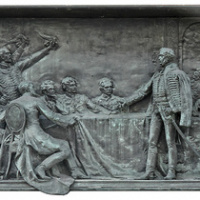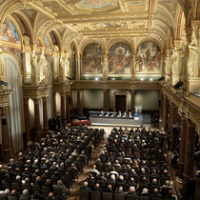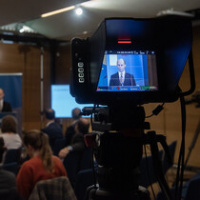The Science of Diastole – Kovács Sándor tiszteleti tag székfoglaló előadása
Kovács Sándor tiszteleti tag 2023. június 21-én megtartotta akadémiai székfoglalóját. Az angol nyelvű előadásról szóló, képgalériával és videóval bővített összefoglaló.
From the time of Aristotle (4th century BC) to Da Vinci (15th-16th century) to Vesalius (16th century) to Harvey (mid-17th century) to Ugander (2017), our understanding of how the heart works as a pump within a closed circulatory system has continued to evolve. Our current understanding of organ level function awaited the development of invasive (cardiac catheterisation) and non-invasive (echocardiography, cardiac CT, cardiac MRI) technology and the measurement of bioelectric phenomena (ECG), as well as the recording of in vivo pressures, flows and volumes. Despite these advances, the current clinical quantification of diastolic function remains correlative rather than causality-/mechanism-based.
 Kovács Sándor
Kovács Sándor (Az akadémiai székfoglaló előadáson készült képgaléria a fotóra kattintva nézhető meg) Fotó: mta.hu / Szigeti Tamás
The realisation that peripheral muscle oscillation requires opposing muscle groups (extensors-flexors) whereas cardiac pumping (oscillation) is achieved by a single muscle (myocardium) that has no opposing muscle group requires further explanation. To appreciate the science of diastole, it is useful to adopt a conceptual framework of the four-chambered heart as primarily a near-perfect ‘constant-volume’ pump that relies on the simultaneous reciprocation of atrial-ventricular volumes during the cardiac cycle. As the ventricles eject, the atria simultaneously fill. Ventricular filling (diastole) requires a rapid drop in ventricular pressure, below atrial pressure, to initiate transmitral flow (Doppler E-wave). Importantly, as the mitral valve opens for a short interval afterward, left ventricular (LV) pressure continues to drop while LV volume rapidly increases (dP/dV<0), meaning that the chamber expands faster than it can fill. It therefore acts as a mechanical suction pump. This process is a cardiohemic inertial oscillation that obeys Newton’s law (equation of motion). The solution (parametrised diastolic filling (PDF) formalism) uses the E-wave contour as input and solves the ‘inverse problem of diastole’ by providing unique values for global chamber stiffness, relaxation and load. Among numerous advances, the PDF framework has solved the ‘load independent index of diastolic function’ (LIIDF) problem, revealed that E-wave asymmetry is due to stiffness-relaxation coupling, and shown that optimal filling is achieved by matching E-wave vortex ring expansion to wall motion. Overall, the science of diastole has advanced our understanding of how the heart works as it fills.
Kovács Sándor 1947-ben született Budapesten. A Kaliforniai Műszaki Egyetemen (California Institute of Technology) szerzett PhD-fokozatot 1977-ben fizikából. A Washingtoni Egyetem Orvostudományi Kar Belgyógyászati Tanszékének (Washington University, School of Medicine, Department of Internal Medicine) sejtbiológia- és fiziológiaprofesszora. Szűkebb szakterülete a kardiológia és a sejtbiológia. Jelentősen hozzájárult az új szemléletű kardiovaszkuláris fiziológia és a klinikai kardiológia eredményeihez. A szív multimodális képalkotása körében új technikai eljárásokat dolgozott ki. Megmagyarázta a harmadik (S3) és negyedik (S4) szívhangok keletkezési mechanizmusát. Matematikailag pontos modellt állított fel parametrikus diasztolés telődés (parameterized diastolic filling, PDF) formalizmus néven, amely a klinikai E-hullám kontúrjából indul ki, és az inverz problémát, a diasztolés esetet is értelmezi. Ezzel megoldotta a terhelésfüggetlen diasztolés funkcionális (LIIDF) problémát. A módszert szabadalmaztatták. Multimodális képalkotás segítségével megalkotta a bal kamra gyors töltődését leíró fizikai modellt.




